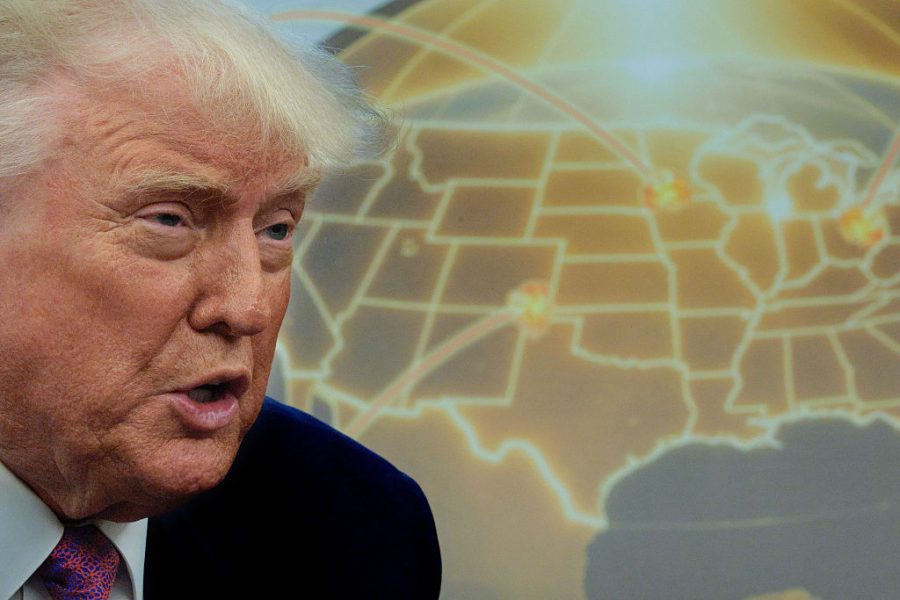Donald Trump did not get to where he is today by taking no for an answer. Mark Carney, the Prime Minister of Canada, could scarcely have been clearer when he visited the White House earlier this month that the President’s notion of Canada becoming America’s 51st state was not even being entertained. ‘Canada is not for sale,’ he said bluntly. When Trump chided him that he should never say never, he mouthed silently, ‘Never, never.’
Undaunted, President Trump has tried a new tack: the proposed Golden Dome, a missile defence system covering the United States which Trump initiated by executive order in January. He announced on his Truth Social platform that Canada was keen to be part of Golden Dome, and he had an offer.
President Trump is preoccupied with grand schemes of perhaps-impossible complexity
It will cost $61 Billion Dollars if they remain a separate, but unequal, Nation, but will cost ZERO DOLLARS if they become our cherished 51st State.
There is something very revealing about the President choosing to invoke the Golden Dome. It is inspired by Israel’s Iron Dome, which has been in service since 2011 and which is astonishingly effective, intercepting between 75 and 90 per cent of targets. But it comes at a fearsome cost, with each of the 10-15 batteries across Israel costing $50 million (£37 million).
President Trump has been impressed by the Iron Dome, and struck by the vulnerability of the United States to missile attack. We saw a glimpse of this at last year’s Republican National Convention when he asked, rhetorically and petulantly, ‘Why should other countries have this and we don’t?’ So, characteristically, he also wants a scaled-up US equivalent and has called it the ‘Golden Dome’.
He is right to be worried. Annie Jacobsen’s brilliant but terrifying book Nuclear War: A Scenario suggests that existing systems controlled by America’s Missile Defense Agency have a success rate of around 55 per cent. Letting half the enemy’s missiles through is not a sustainable option.
Trump’s executive order deals with something far vaster and more complicated than a magnified Iron Dome, which protects against short-range ballistic missiles. The President has demanded ‘defence of the United States against ballistic, hypersonic, advanced cruise missiles, and other next-generation aerial attacks from peer, near-peer, and rogue adversaries’. It would involve space-based, orbiting ‘interceptors’ as well as batteries on the ground.
The President has announced that the Golden Dome will cost $175 billion (£130 billion) and will be operational before his term ends in January 2029. To say this is ambitious is like accusing Joe McCarthy of mild anxiety about Communist infiltration. The Congressional Budget Office has estimated a cost of between $542 billion (£403 billion) and $831 billion (£619 billion) for a relatively limited system. Some doubt that such an ambitious scheme is possible at all.
While President Trump contemplates his money-no-object Wunderwaffe, Europe, for once, is taking practical and pragmatic steps to rearm. Earlier this month, Britain and Germany announced they would cooperate on a new precision deep-strike capability with a range of more than 1,200 miles; Germany has signed a letter of intent with Ukraine to work together and manufacture long-range weapons in Ukraine and, it implied, procure them for the Bundeswehr. Rolls-Royce, meanwhile, has been chosen to supply MT30 gas turbine engines to Canada’s new River-class destroyers and the South Korean navy’s Ulsan-class frigates.
It even seems that the UK/Italy/Japan global combat air programme to deliver sixth-generation stealth fighters by 2035 has survived the UK’s Strategic Defence Review. Sweden, Saudi Arabia and Australia have shown interest in also joining the consortium.
Rearmament across Europe will be hard: it will cost more money than politicians are yet willing to admit. It must be accompanied by radically faster and more efficient procurement processes and the European defence industry will need to expand and think flexibly and innovatively. Suddenly, however, projects are beginning to move that focus on the capabilities we need. Meanwhile, President Trump, his Department of Defense in disarray and headed by a Secretary of Defense who is simply not up to the job, is preoccupied with grand schemes of perhaps-impossible complexity, costing hundreds of billions of dollars, inured as ever to voices of reality.
Perhaps it was Trumpian shock therapy which changed Europe’s attitude. But the President has always been better at giving than receiving advice. Some things never change.








Comments